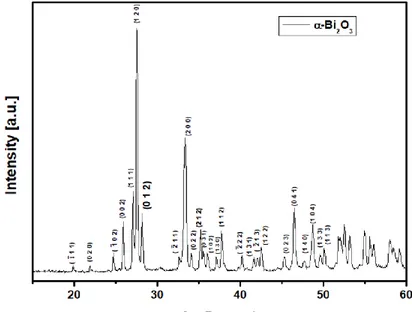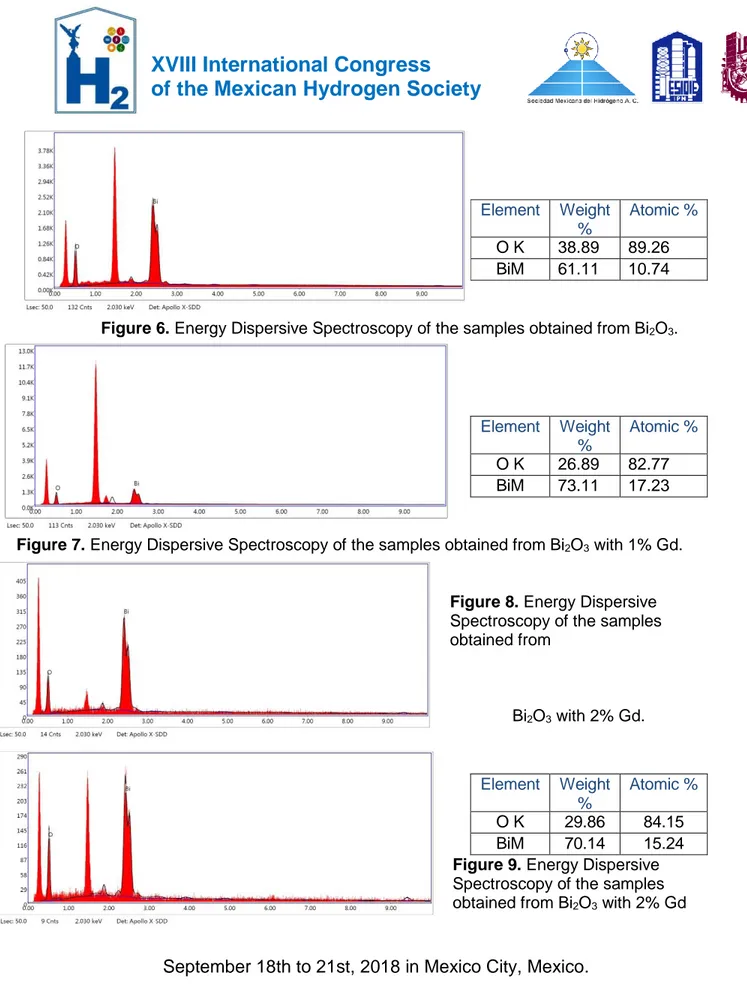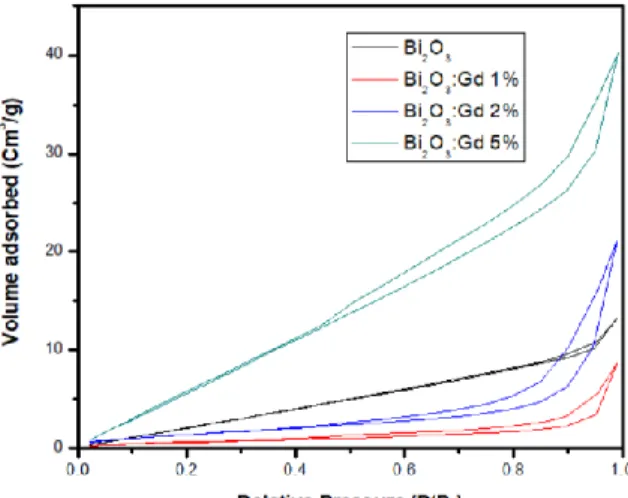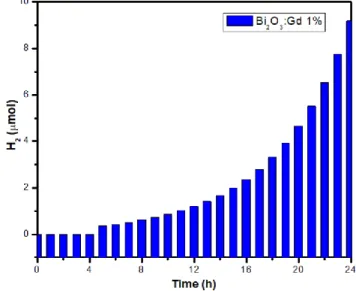Synthesis and characterization of Bi2O3:Gd for hydrogen production under visible light
Texto completo
(2) XVIII International Congress of the Mexican Hydrogen Society stored in several different ways. Hydrogen is also considered as a high efficiency, low polluting fuel that can be used for transportation, heating, and power generation in places where it is difficult to use electricity. In some instances, it is cheaper to ship hydrogen by pipeline than sending electricity over long distances by wire. However, the large-scale H2 production is mainly based on fossil fuels splitting or water electrolysis, which has led to high energy consumption and severe environmental pollution. Since the pioneering work of Fujishima and Honda on semiconductor photocatalysis, the direct H2 production via water splitting using solar energy has been extensively investigated as a promising way to meet the ever-growing global energy demands. Bi2O3 semiconductor photocatalyst has gained considerable attention due to its good absorption capacity (band gap of 2.8 eV) and found to be very good catalyst for environmental application as well as photocatalytic water splitting. 2. Material and methods Reagents Bi(NO3)3·5H2O. Aldrich. 98%. Gd(NO3)3·5H2O. Aldrich. 98%. Ethylene glycol. Aldrich. >99%. Tartaric acid. E. Merck. 99.5%. HNO3. J.T. Baker. 69-70%. Water. ---. Deionized. NaOH. J.T. Baker. 89%. To obtain Bi2O3 by the Pechini method, we used Bi(NO3)3•5H2O and Gd(NO3)3•5H2O as a precursor, tartaric acid as a chelating agent and ethylene glycol as a polymeric agent, Bi(NO3)3•5H2O was dissolved in a 5% HNO3 solution, with moderate agitation for 30 minutes to obtain a transparent solution of Bi+3. On the other hand, a solution of tartaric acid was prepared, this solution was added dropwise to the Bi+3 solution to carry out the chelation of the metal in a 1: 1 molar ratio. To this mixture was added ethylene glycol in a 1:1 molar ratio (tartaric acid: ethylene glycol), the addition was made drop by drop to polymerize the previously formed complex. The mixture stirred for a period of 24 h and subsequently adjusted to pH 0.5 with NaOH at 25% with a potentiometer, until forming a dense sun. Through a reflux system, the formed sun was heated at 80 °C for 2 h and then at 105 °C for 2 h to achieve condensation and finally kept in slow agitation for 24 h. Later we proceeded to eliminate the remaining solvent using a rotaevaporator with a water bath at 90 °C to get the xerogel. The xerogel was dried at 95 °C for 2 h and subsequently the white solid has been pulverized and calcined in a muffle at 390 °C for 3 h, with a heating ramp of 2 °C min1 .. September 18th to 21st, 2018 in Mexico City, Mexico.. 651.
(3) XVIII International Congress of the Mexican Hydrogen Society 3. Results and discussion 3.1. XRD The diffractogram of figure 1 shows that the phase obtained from undoped Bi2O3 by the Pechini method is the monoclinic alpha phase, in the figure 2 when the Bi2O3 was doped with the gadolinium, we obtain a mixture of phases due to a transition in the crystalline structure of the material. Phase transition occurs from the monoclinic alpha phase to a tetragonal beta phase, as we can see in figure 2 this probably due to the rearrangement of the atoms when gadolinium is added to the catalyst, finally, in figure 3 we can see that we only have present the beta phase of the material, which has been reported as the most photoactive crystalline phase.. Figure 1. Diffractogram obtained by XRD of pure Bi2O3 without doping.. September 18th to 21st, 2018 in Mexico City, Mexico.. 652.
(4) XVIII International Congress of the Mexican Hydrogen Society. Figure 2. Diffractogram obtained by DRX of Bi2O3 doped with 1% gadolinium.. Figure 3. Diffractogram obtained by DRX of Bi2O3 doped with 2% gadolinium. 3.2.. DRS Uv-Vis. It can be observed in figure 4 that when doping the material with gadolinium a change is obtained in the optical Bandgap of the material, the Bandgap obtained with the pure Bi2O3 is 2.95 and it is possible to reduce it to a value of 2.53 when doping with gadolinium.. September 18th to 21st, 2018 in Mexico City, Mexico.. 653.
(5) XVIII International Congress of the Mexican Hydrogen Society. Figure 4. Calculation of optical Bandgap using the diffuse reflectance method Uv-Vis. 3.3.. Scanning Electron Microscopy (SEM)- Energy Dispersive Spectroscopy (EDS).. In figure 5 we can observe the formation of bars and flakes of Bi2O3, the formation of these structures are characteristic of the synthesis method and the material, which have been previously reported. In the Energy Dispersive Spectroscopy results the presence of bismuth oxide was confirmed. Figure 5. Scanning electron microscopy of the samples obtained from Bi2O3.. September 18th to 21st, 2018 in Mexico City, Mexico.. 654.
(6) XVIII International Congress of the Mexican Hydrogen Society. Element OK BiM. Weight % 38.89 61.11. Atomic % 89.26 10.74. Figure 6. Energy Dispersive Spectroscopy of the samples obtained from Bi2O3.. Element OK BiM. Weight % 26.89 73.11. Atomic % 82.77 17.23. Figure 7. Energy Dispersive Spectroscopy of the samples obtained from Bi2O3 with 1% Gd.. Figure 8. Energy Dispersive Spectroscopy of the samples obtained from. Bi2O3 with 2% Gd.. Element. Weight Atomic % % OK 29.86 84.15 BiM 70.14 15.24 Figure 9. Energy Dispersive Spectroscopy of the samples obtained from Bi2O3 with 2% Gd. September 18th to 21st, 2018 in Mexico City, Mexico.. 655.
(7) XVIII International Congress of the Mexican Hydrogen Society 3.4.. N2-fisisortion (BET). Type IV isotherms were obtained which are characteristic of the mesoporous solids, this hysteresis cycle is due to the mesoporous filling process which is governed by capillary condensation phenomena, the hysteresis loops are type 3, which are obtained when working with pore agglomerates of parallel plates, which agrees with the micrographs obtained in MEB where the formation of flakes in the material can be seen, the Bi2O3 catalysts had a low specific area, they did not present a significant change in the pore radius, and an increase in the specific area was observed in the Bi2O3:Gd 5% samples.. Figure 10. Nitrogen fisisorption isotherms of catalysts based on Bi2O3. Element OK BiM Bi2O3 2. Weight Atomic % % 32.87 86.48 67.13 13.52 Bi2O3:Gd 1% Bi2O3:Gd 2%. Bi2O3:Gd 5%. Surface Area (m /g). 9.983. 2.037. 5.092. 28.279. Pore Volume. 0.020. 0.013. 0.032. 0.061. 15.441. 15.440. 15.291. 15.243. (Cm3/g) Pore Radius Å 3.5.. Photocatalytic evaluation of hydrogen production.. It can be seen in the graphs that the material with the best performance with respect to hydrogen production was Bi2O3: Gd 2%, obtaining a considerably better performance than. September 18th to 21st, 2018 in Mexico City, Mexico.. 656.
(8) XVIII International Congress of the Mexican Hydrogen Society that obtained with Bi2O3: Gd 1% and Bi2O3: Gd 5%, the doping of the gadolinium material favored the production of hydrogen. Hydrogen production was not obtained with the pure Bi2O3 catalysts.. Figure 11. Photocatalytic evaluation of hydrogen production with Bi2O3 catalyst:Gd 1%.. Figure 12. Photocatalytic evaluation of hydrogen production with Bi2O3 catalyst:Gd 2%.. September 18th to 21st, 2018 in Mexico City, Mexico.. 657.
(9) XVIII International Congress of the Mexican Hydrogen Society. Figure 13. Photocatalytic evaluation of hydrogen production with Bi2O3 catalyst:Gd 5%. 3.6.. Discussion. The addition of gadolinium at different percentages in the catalyst affects its optical and structural properties, causing a phase change due to a transition in the crystalline structure of the material. The phase transition occurs from the monoclinic alpha phase to a tetragonal beta phase, due to the rearrangement of the atoms as gadolinium is added to the catalyst. A reduction of the Bandgap in the doped materials was also obtained, since the Bi2O3 presents an optical Bandgap of 2.95 eV and when adding the gadolinium to the material, a reduction of the optical Bandgap is obtained up to a value of 2.53 eV and therefore a better photocatalytic activity in the visible light spectrum. The isotherms obtained by nitrogen fisisorción are type IV which are characteristic of the mesoporous solids, in addition to presenting hysteresis loops of type 3 which agree with pores of parallel plates type, these results agree with the micrographs obtained in the MEB, in which the formation of bars and flakes characteristic of the synthesis method can be observed. Finally of the synthesized materials, the best was the Bi2O3:Gd 2%, which presented a crystalline structure in the tetragonal beta phase, which has been reported as the most photoactive phase. 4. Conclusions The doping of Bi2O3 materials in different percentages could allow to improve their optical and structural properties, alpha and beta crystalline structure of the material was obtained, the beta phase showed the greatest photocatalytic activity, a transition between the crystalline phases was achieved by changing the percentage of gadolinium in Bi2O3, materials with a Bandgap between 2.95 eV - 2.53 eV were also obtained, which allows a better photocatalytic activity of the material in the visible spectrum, the micrographs achieved the characteristic morphology of the synthesis method, finally the results obtained in Photocatalytic evaluation of hydrogen production showed that the. September 18th to 21st, 2018 in Mexico City, Mexico.. 658.
(10) XVIII International Congress of the Mexican Hydrogen Society material with the best photocatalytic activity is Bi2O3: Gd 2%, probably due to the fact that it has the lowest Bandgap and a tetragonal beta crystalline structure, which has been reported as the most photoactive phase of Bi2O3. 5. Acknowledgments The authors are thankful to Universidad Juárez Autónoma de Tabasco and Centro de Investigacion en Materiales Avanzados, S. C. Furthermore, and XVIII International Congress of the Mexican Hydrogen Society for the fellowship to present this research. 6. References K.Gurunathan. (2004). Photocatalytic hydrogen production using transition metal ionsdoped γ-Bi2O3 semiconductor particles. International Journal of Hydrogen Energy, 29, 933– 940. S. H. Hsieh, G. J. Lee. (2012). Synthesis of Pt Doped Bi2O3/RuO2 Photocatalysts for Hydrogen Production from Water Splitting Using Visible Light. Journal of Nanoscience and Nanotechnology, 12, 5930–5936. Jingrun Ran, Jun Zhang. (2013). Earth-abundant cocatalysts for semiconductor based photocatalytic water splitting. Chem. Soc. Rev., 43, 7787-7812. Brundabana Naik, Satyabadi Martha, K.M. Parida. (2011). Facile fabrication of Bi2O3/TiO2xNx nanocomposites for excellent visible light driven photocatalytic hydrogen evolution. International journal of hydrogen energy, 36, 2794-2802. N. Lakshmana Reddy, G. Krishna Reddy. (2016). Highly Efficient Hydrogen Production using Bi2O3/TiO2 Nanostructured Photocatalysts Under Led Light Irradiation. Materials Today: Proceedings, 3, 1351–1358. Kazuhiko Maedaa. (2011). Photocatalytic water splitting using semiconductor particles: History and recent developments. Journal of Photochemistry and Photobiology C: Photochemistry Reviews, 12, 237-268. Hankwon Lim, Sher Bahadur Rawal. (2017). Integrated Bi2O3 nanostructure modified with Au nanoparticles for enhanced photocatalytic activity under visible light irradiation. Progress in Natural Science: Materials International, 27, 289-296. S. H. Hsieh, G. J. Lee. (2012). Synthesis of Pt Doped Bi2O3/RuO2 Photocatalysts for Hydrogen Production from Water Splitting Using Visible Light. Journal of Nanoscience and Nanotechnology, 12, 5930-5936.. September 18th to 21st, 2018 in Mexico City, Mexico.. 659.
(11) XVIII International Congress of the Mexican Hydrogen Society K.Gurunathan. (2004). Photocatalytic hydrogen production using transition metal ionsdoped γ-Bi2O3 semiconductor particles. International Journal of Hydrogen Energy , 29, 933940. Rishabh Sharma a, Manika Khanuja. (2017). Reduced band gap & charge recombination rate in Se doped α-Bi2O3 leads to enhanced photoelectrochemical and photocatalytic performance: Theoretical & experimental insight. International Journal of Hydrogen Energy, 42, 20638-20648.. September 18th to 21st, 2018 in Mexico City, Mexico.. 660.
(12)
Figure




Documento similar
1.6 Recombinant production in E.coli and characterization of the proteolytic activity of different constructs of the Catalytic Domain of USP28 and USP25 with
No obstante, como esta enfermedad afecta a cada persona de manera diferente, no todas las opciones de cuidado y tratamiento pueden ser apropiadas para cada individuo.. La forma
In order to better understand and make progress in the investigation of the so- called low-temperature universal properties of non-crystalline solids and the phenomena of
In the second part of this thesis, the molecular and structural characterization of Ad5/FC31 light particles revealed that these particles lack genome and
The acid doping enhanced proton conductivity of PBI membranes and, after doping, these conducting materials maintained their mechanical properties and thermal stability for
Two modification methods (MI and PI) were studied for the degradation of triclosan, under visible light.. 2.1 Characterization and properties of nano-ZnO/Graphene
Of special concern for this work are outbreaks formed by the benthic dinoflagellate Ostreopsis (Schmidt), including several species producers of palytoxin (PLTX)-like compounds,
The crystalline quality of these powders is very low in comparison with single crystals, and consequently their optical characterization involves all kinds of crystal and grain


